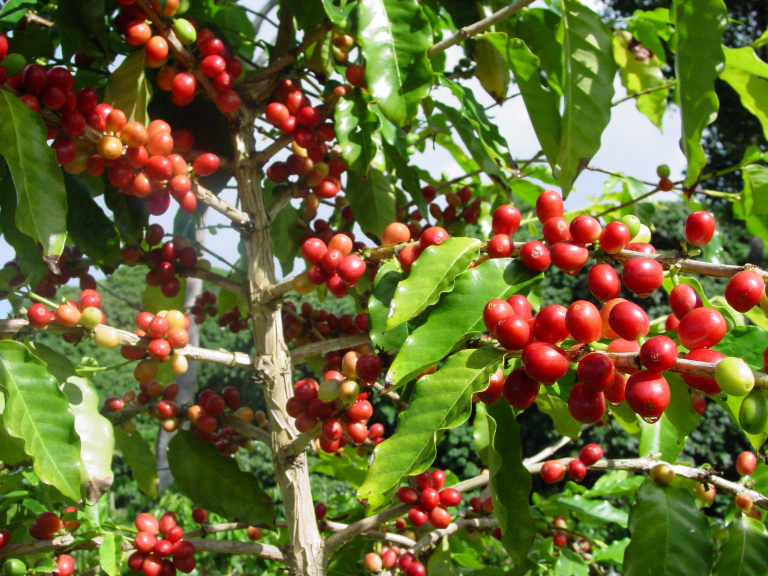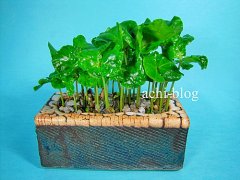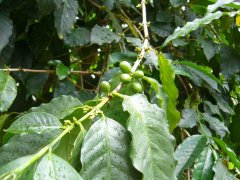Coffee growing conditions when is the right time to grow coffee? How to plant coffee trees?

Professional coffee knowledge exchange More coffee bean information Please pay attention to coffee workshop (Weixin Official Accounts cafe_style)
What are the fruits and seeds of coffee? Coffee beans look like fruit.
Coffee is one of the top three drinks in the world, but do you know how it is grown? Today's study Xiaobian will tell you about planting coffee trees.
Coffee plantation
1, the excavation of planting ditch excavation quality affects the coffee garden soil and water conservation, the implementation of agricultural technical measures, coffee tree growth and yield of major events, to be seriously implemented. Excavation method: gentle slope can be excavated from the bottom of the slope to the top of the slope, while steep slope should be excavated from the top of the slope to the bottom of the slope, which can minimize the phenomenon that the soil in the upper ditch rolls into the next ditch. The specification of planting ditch is 0.60 m wide at the mouth and 0. 40 meters, depth 0. 50 meters. During excavation, the topsoil of trench surface shall be excavated. Stack them above the ditch, dig out the subsoil in the ditch and stack them below the ditch. The depth of the ditch shall be below the edge of the mouth. All roots and stones in the planting ditch shall be cleared out. Trees between platforms shall be reserved and shall not be felled at will. The excavation time should be from October before winter to February in spring, and should be completed in May at the latest.
2. Soil returning and platform building 15 - 30 days before planting, soil returning for the first time is 0. 20 meters, then add 1500 kg farm manure +100 kg phosphate fertilizer per mu, evenly stir the base fertilizer. After the second soil return, the groove will be filled up and the level ladder will be carried out. The table width is required to be 1. 20 meters, table inclined 2 - 3 degrees. After finishing the table, lime powder will be evenly spread on the table, the purpose is to adjust the soil PH value, enhance the soil microbial activity, and improve the effectiveness of soil mineral nutrients.
3. The specifications of digging holes and applying base fertilizer for planting holes are generally 0.40 m × 0.40 m × 0. 30 meters, before planting, apply 0.10 - 0.25 kg of calcium superphosphate per hole, if conditions permit, apply 3 - 5 kg of organic fertilizer per hole, and fully mix the fertilizer with the hole soil, otherwise the coffee seedlings will be fertilized after planting.
Coffee planting
The planting time is selected in June to July after the beginning of the rainy season. The planting day is cloudy or rainy, and it can be planted all day. If the planting day is sunny, it should be planted before 11:00 a.m. and after 4:30 p.m. Seedlings should choose 4 - 5 pairs of true leaves, height of 0.15 meters or more, no branches of healthy seedlings. The planting plant spacing is 1m × 2m, 333 plants are planted per mu, the bottom of the seedlings is cut off by 0.03m, the nutrient bag is stripped, and the nutrient soil is placed in the hole, the height of the nutrient soil is consistent with that of the platform surface, the fine soil is backfilled layer by layer after the seedlings are righted, and the nutrient lump is compacted gently after the soil is restored, so that the nutrient lump is effectively combined with the surrounding soil. After the coffee planting is finished, the platform is comprehensively trimmed once, and the platform is kept clean, flat and inclined inward. After planting for 10 days, check row by row, and if holes, dead seedlings and damaged seedlings are found, replace them in time to achieve complete seedlings.
Coffee growing seedlings
1, the choice of nursery land close to the water source, convenient transportation, loose fertile soil, deep soil layer, good drainage loam or sandy loam, PH 6 - 6.5 paddy field or early nursery land, and close to the coffee garden. Turn the ground 0.20 - 0. 30 meters, ridge width 1.0 - 1. 2 meters, about 10 meters long, and apply decomposed farm manure on the soil moisture, 3000 kg per mu, mix the soil and fertilizer evenly as nutrient soil for bagging, nutrient bag specification is 0.15× 0.20 meters, put nutrient soil into bags, 12 bags in each row are neatly placed, upright, 60 - 70,000 plants can be placed per mu, shade branches are planted according to the pile spacing of 4 meters, height 2. 0 meters shade density 75 - 85%, surrounded by fences to protect shade, nursery will be built.
2, germination bed finishing and sowing will have been hoe fine, fertilizer nursery by spacing 0. 50 meters, width 1. 20 meters, height 0.15 - 0. 20m ridge soil spreading, soil disinfection with carbendazim, adding 0.05 - 0.10m thick river sand can be, Fu dam planting 7963 new varieties, about 5000 seeds per kilogram, soaking in warm water at 40 - 45℃ for 2 - 3 minutes, then soaking in clean water for 24 hours, taking out seeds evenly sown on the sand bed, to avoid accumulation is appropriate, sowing rate is 0.50 - 0.60kg/square meter, pressing into the sand with wood, Covers 0.01 - 0. 02 meters of river sand, then covered with straw on the surface, poured through water. 80 days after sowing, the seeds are unearthed, watered regularly before they are unearthed to prevent drought, and the seedlings are uncovered in time.
3. Seedling management after transplanting nutrition bags Before transplanting bags, pest control should be carried out. Carbendazim and thiophanate-methyl should be used to control seedling blight, dimethoate should be used to control pests and diseases. When the cotyledons of seedlings are completely unfolded, they can be transplanted. Before plucking seedlings, water should be drenched to reduce root damage during plucking. Select stable and healthy seedlings. Use buckets or pots to hold 0.10 meters of water. Put seedlings neatly into containers for preservation. Before transplanting seedlings, water should be drenched in nutrient bags filled with nutrient soil. After seedlings are inserted into nutrient bags, roots should be straight and seedlings should be upright. After planting, the root water is poured. During the nursery period, attention should be paid to pulling out weeds and preventing diseases and pests. The human and animal feces should be applied 2 - 3 times. The proportion of 1:3 should be mixed with water. The leaves should be sprayed once with 0.5% Yunda 120. When the plant height is 0 . 4 - 5 pairs of true leaves of 15 meters can be transplanted, and 2 - 3 weeks of seedling training should be carried out before transplanting.
Daily management of coffee cultivation
1. The root system of intertilled coffee grows with the growth of plants. Half a year after planting, the root system grows beyond the range of planting holes. Therefore, it is best to carry out deep ploughing six months after planting to one year before the rainy season, according to the soil conditions and root distribution and depth, generally 0.4 - 0.5 meters is appropriate.
2, fertilization coffee fertilization to master the type of fertilizer and fertilizer, both to the right amount, but also to prevent excessive. Insufficient fertilization will lead to yellowing of leaves, withered shoots, fruit drop, premature aging and other phenomena; excessive fertilization will not only cause waste, but also deteriorate the soil. Young coffee trees are in vegetative growth period, fertilizer application should be based on nitrogen and phosphorus, appropriate application of potassium fertilizer to promote root and branch growth, accelerate the formation of crown, cultivate good tree type, lay the foundation for high yield, but fertilizer application should grasp the principle of frequent application and thin application. Fertilization of coffee trees should be based on nitrogen and potassium fertilizer, combined with phosphorus fertilizer and other elements.
The fertilization scheme adopted was that urea 20g/plant was applied for the first time 20 days after the young trees planted in the same year survived, and nitrogen, phosphorus and potassium mixed fertilizer 30g/plant was applied for the second time before the end of rainy season. In the second year, the first time of fertilization is in February to March, the second time is in May to June, and the third time is in August to September. Each time, nitrogen, phosphorus and potassium mixed fertilizer is applied 100g/plant. In the third year, the first time of fertilization is combined with intertillage and weeding in February and March, and the second time is applied in May and June, and the third time is applied in August and September. Fertilization of coffee trees in production: 1500g oil cake/plant was applied in February and March for the first time, and 150g nitrogen, phosphorus and potassium mixed fertilizer was applied to each plant in May, July and September for the second, third and fourth times respectively. Coffee tree fertilization method: young trees from the base of the department 0. At 20 meters, mature trees dig circular or semi-circular fertilizer ditches at the dripping position of the plant crown, with a width of 0. 20 meters, 0.20 - 0.30 meters deep, immediately covered with soil after fertilization.
3. Weeding coffee garden countertops should be kept clean and weed-free at any time to avoid competition between grass and coffee for nutrients. Weeding should be done once a month, 0. Weed with hoe and intertillage outside 30 meters, uproot with hand within 0.30 meters of tree base to avoid damaging rhizomes. Weed branches on coffee stems are not allowed to be uprooted with hoes to avoid damaging terrace ladders and soil erosion. Weed trees on stems can obtain shade, maintain soil and water, and reduce pest damage to coffee.
fresh period
The initial production period refers to the period from the beginning of production to the arrival of full production. During this period, coffee begins to enter reproductive growth, coffee trees grow vigorously, and nutrient demand is very large.
prolific period
After the initial period of 1-2 years or so into the peak period, coffee trees generally 3- 4 years to bloom, about 2- 3 months each year, appearance and smell similar to jasmine, flowering closely born in clusters, flowering 3- 5 days. After flowering, they bear small green fruit, a few months later mature into red can be picked ripe fruit.
The ripe fruit skin is red, and due to its shape and color similar to cherries, mature coffee fruits are called coffee cherries in many places. Beneath the bright red exocarp are the pericarp, pulp, and a sweet, sticky yellow substance that encases the beans.
Properly managed, it can last for about 30 years.
recovery storage
Coffee beans can be harvested when the skin begins to turn red. Fruit picking period varies with species, small seed is picked from September to November, and September to October is the peak fruit period; medium seed is picked from November to June of the next year, and February to April is the peak fruit period. There are two processing methods:
a. drying method: drying or drying fresh fruit, peeling off pericarp and seed coat with a hulling machine, and sieving impurities.
b. Wet method: This method is used for large-scale production. peeling fresh fruits with a peeling machine, separating bean grains from pericarp, soaking the peeled bean grains in water for degumming, cleaning, drying, and removing seed coat to obtain commercial coffee beans.
。
Important Notice :
前街咖啡 FrontStreet Coffee has moved to new addredd:
FrontStreet Coffee Address: 315,Donghua East Road,GuangZhou
Tel:020 38364473
- Prev

Can coffee trees be planted at home? Pot DIY tutorial on how to grow a pot of coffee seeds at home
Professional coffee knowledge exchange more information about coffee beans Please follow the coffee workshop (Wechat official account cafe_style) what are the fruits and seeds of coffee? Although the coffee tree is called a tree, it is actually an evergreen shrub and is a tropical plant. A normal coffee tree can usually grow to 3 to 9 meters high, but for the convenience of harvesting, ordinary farmers
- Next

Coffee planting technology: how to make coffee trees grow up quickly? Improve the success rate of planting?
Professional coffee knowledge exchange more information about coffee beans Please follow the coffee workshop (Wechat official account cafe_style) what are the fruits and seeds of coffee? The coffee tree is a tropical plant that belongs to an evergreen shrub that grows at the equator and 25 degrees north and south latitudes, that is, within the Tropic of Cancer. Near the Tropic of Cancer and the equator is the world coffee.
Related
- Beginners will see the "Coffee pull flower" guide!
- What is the difference between ice blog purified milk and ordinary milk coffee?
- Why is the Philippines the largest producer of crops in Liberia?
- For coffee extraction, should the fine powder be retained?
- How does extracted espresso fill pressed powder? How much strength does it take to press the powder?
- How to make jasmine cold extract coffee? Is the jasmine + latte good?
- Will this little toy really make the coffee taste better? How does Lily Drip affect coffee extraction?
- Will the action of slapping the filter cup also affect coffee extraction?
- What's the difference between powder-to-water ratio and powder-to-liquid ratio?
- What is the Ethiopian local species? What does it have to do with Heirloom native species?

